Why Is Stainless Steel So Important in Nuclear Power Plants?

Dec 17, 2014
Anyone in the nuclear industry knows that steel plays a critical role in protecting both people and materials. But in a post-Fukushima world, even industry insiders want to know how to make their processes safer. Stainless steel and other super alloys factor into this goal.
To understand how stainless steel factors into nuclear reactors, first familiarize yourself with a reactor’s components. You should also learn what matters to nuclear engineers, and investigate the best alloys for a nuclear application.
The Quintessential Reactor
If you consider the typical reactor, you’ll see a lot of stainless steel assemblies throughout the plant. Austenitic stainless steel is most often used to construct pipes other process-related vessels.
The reactor itself includes these general components:
Fuel and Coolants – Uranium oxide balls are stored in tubes to fuel the plant, while coolant continually circulates around the core to keep it from overheating.
Pressure tubes – These contain either fuel or coolants (see above). Some plants use larger vessels to contain their moderator or coolant. Either way, these tubes or vessels are made generally from stainless steel.
Steam generators – When the reactor produces heat, a pressurized coolant uses it to create steam, which powers the turbines. Most reactors contain several steam generators.
Moderators – The moderator (graphite or water) sits within the reactor’s core and slows fission-produced neutrons.
Rods – Created to control or curtail nuclear reactions, control rods reside in the reactor core. They contain boron, cadmium, or hafnium—all of which absorb neutrons effectively.
Containment vessels – The largest stainless steel structures protect the reactor from outside intrusions. More importantly, these steel/concrete vessels protect workers from radiation.
Case Study: Stainless Steel Inside a French Nuclear Plant
Anyone in the nuclear industry can learn from the engineers at Cogema. Cogema is a French nuclear reprocessing plant near Cherbourg.
During their daily processes, Cogema engineers take care of everything from processing to recycling. They recycle spent fuel materials such as plutonium and uranium, leaving fissionable waste for disposal.
The Cogema plant requires a vast amount of austenitic stainless steel (mostly 304L and 316L grade) for its applications and operations. The complex is so large that it requires many kilometres of pipes to cover its expanse.
Additionally, stainless steel is important for low- or high-corrosion implementation. Examples of the former are robots and chimneys, while tanks and containment canisters are examples of the latter. Further, the plant uses 304L for process-related applications and 316L for fission storage. If a process involves highly corrosive materials, the plant uses other super alloy blends at higher thicknesses.
In order to deal with corrosion, Cogema engineers choose their materials carefully. They pay special attention to chemical conditions and raw materials such as cast alloys. They also have to account for the purpose of each vessel (gas treatment, dissolution, and so forth).
Likewise, if a component exhibits ferritic corrosion, the steel must contain a 3 percent maximum of ferrites in order to resist cracking.
To learn more about this nuclear plant, read the full article here.
Austenites, Super Alloys, and New Steel Classes
As any nuclear engineer knows, austenitic steels work best in hot environments where corrosion is standard. This type of stainless steel can withstand higher temperatures than ferritic steel, even though both may be present in a typical reactor.
To get a better idea of how various stainless steel types compare, consider a fourth-generation reactor that reaches 1,000° Celsius. In most cases, austenitic steel performs better than ferritic steel under these extremes. However, both metals can be compromised under constant neutron attack.
Even so-called super alloys (nickel based) may have a difficult time under similar conditions as those mentioned above. Under constant exposure to neutrons and corrosion, they can form helium bubbles and weaken over time.
As nuclear engineers develop more high-temperature reactors, steel manufacturers have to keep pace. A class of ferritic-martensitic stainless steels appears promising. This type of steel was developed partly at the urging of the fossil energy sector. It appears to hold up well against nuclear temperature extremes, corrosion, and other detrimental influences.
The Future of Corrosion-Resistant Steel
Despite any contrary reports, nuclear energy continues its upward pace. This means there will always be a need for stronger steel components in future reactors. Most nuclear scientists agree that the demand for clean nuclear energy will continue to grow in ensuing decades.
As demand increases, stainless steel manufacturers create new alloys to meet ever-more-stringent requirements. This includes stronger steam generators, tube sheets, pump castings, and corrosion-resistant pressure vessels. All of these components are vital to the nuclear industry.
As the world demands safer, more sustainable energy options, it’s clear that the steel industry will play a critical role in the future of sustainable energy. Thanks to the expertise of global steel suppliers, the future of nuclear energy appears bright.
About James Duva Inc.
Since 1978, James Duva Inc. has been your trusted source for stainless steel and high-nickel alloy industrial products. Whether you’re in the water treatment, process or power industry, we pride ourselves on always having what you need. Say goodbye to your sourcing problems with just one call to James Duva.
